Adrian Collins's Blog, page 49
July 15, 2024
Review: The Last Shield by Cameron Johnston
If Gemmell had a small crew of protégés, I think Cameron Johnston has placed himself at their forefront with The Last Shield. A heroic dark fantasy with plenty of grit, high stakes, battles, and bloody-grinned relentless no-giving-up protagonists, The Last Shield is an un-put-downable thrill ride.
 In The Last Shield, Briar is the leader of the Regent of Sunweald’s personal bodyguard. Armed with buckler and sword and honed by a lifetime of training, the Shields keep the leaders of their realm alive. When one of them goes rogue, and a mysterious bowman cripples Briar, a devious plot is revealed and it puts the one person Briar loves (but cannot have) in danger–and with that person in danger, all of Sunweald is in danger.
In The Last Shield, Briar is the leader of the Regent of Sunweald’s personal bodyguard. Armed with buckler and sword and honed by a lifetime of training, the Shields keep the leaders of their realm alive. When one of them goes rogue, and a mysterious bowman cripples Briar, a devious plot is revealed and it puts the one person Briar loves (but cannot have) in danger–and with that person in danger, all of Sunweald is in danger.
If you mixed Gemmell’s storytelling with Die Hard, I think you would find The Last Shield. With a gruff hero who just won’t die, a villain with evil deeds on their mind, treachery, non stop action and bloody, rather inventive deaths hitting you every few pages in this against-all-odds action film of a book, The Last Shield is going to be popular.
Briar is one of my favourite characters so far in 2024. I punched the air when she won, puckered right up when she was in danger, and really loved her hero’s story. My personal tastes will always lean towards the more morally grey, which you won’t really find in The Last Shield, but for something that I just had a really damned good time reading, Cameron’s Briar was a world of fun.
Another of the other POVs, Kester, was painted as this spoiled brat throughout, which is where at first I was hoping to find that more morally grey character. I would have enjoyed seeing Johnston lean heavier into that aspect of his character. However, the story didn’t really need it more than it needed his redemption arc, and I’m not an author, and this isn’t my book. The Last Shield isn’t about that—it’s more a 90’s action flick in book form. It’s Charlise Theron in The Old Guard, except in a medieval fantasy world. It’s get yourself a beer and a bucket or popcorn, kick your feet up, and forget the world exists while Briar kicks some arse, and I fucking loved that about it.
I’d be quite surprised if The Last Shield doesn’t do well on the heroic fantasy-focussed best-of lists this year. It’s about the most fun reading I’ve had in 2024.
Read The Last Shield by Cameron JohnstonThe post Review: The Last Shield by Cameron Johnston appeared first on Grimdark Magazine.
July 14, 2024
An Interview with Elizabeth Helen
Elizabeth Helen is the pen name of sister duo, Elizabeth and Helen, authors of a hot new fantasy series inspired by Beauty and the Beast. Fairy tales have traditionally explored the darker aspects of human nature and this is no different, the authors have created a dangerous world with flawed and complex characters who are trapped in cursed situation fully of their own making. We’re hooked already and couldn’t resist the opportunity to talk to the authors in advance of the July publication of the first three books of the series in stunning new hardback editions.
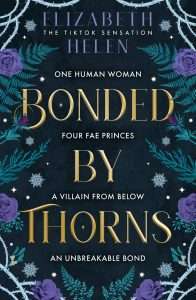 [GdM] Congratulations on the beautiful new hardback editions of your series, Beasts of the Briar. Can you introduce the first book, Bonded by Thorns, in one or two sentences for our readers?
[GdM] Congratulations on the beautiful new hardback editions of your series, Beasts of the Briar. Can you introduce the first book, Bonded by Thorns, in one or two sentences for our readers?
[EH] Hi, thank you so much for having us! Bonded by Thorns is a why-choose, fantasy romance Beauty and the Beast retelling. When an adorkable bookworm wanders into the fae realm, she is imprisoned in an enchanted castle by four princes cursed to turn into beasts every night until they can find their fated mate.
[GdM] I’d love to know more about your inspiration for Bonded by Thorns. What made you choose Beauty and the Beast as the basis for the series?
[EH] We have always loved fairy tales, and Beauty and the Beast was our favourite. The themes of seeing the beauty within, the transformational power of love, and found family really resonated with us. We also thought there were so many fun elements that would work in a why-choose book!
[GdM] Why choose and reverse harem are some of my favourite romantasy tropes. Why did you decide to go this route and did you worry about their appeal to wider audiences?
[EH] Fantasy romance has always been our favourite genre to read and write in. We were noticing why choose/reverse harem was very popular in more contemporary genres, such as dark romance, mafia romance, and sports romance, but there seemed to be a gap in the market for a fantasy with these elements. We hadn’t written a why choose at this point, and thought it would be a fun experiment to try a fairytale retelling!
We knew why chose can be niche and weren’t sure how broad the market would be for a fantasy; it was definitely experimental. Now, one of the best compliments we get from our readers is either that this was their first introduction to why choose or their first introduction to fantasy!
[GdM] Can you tell us more about the fae in your novel?
[EH] When designing the world of the Enchanted Vale, we knew we wanted it to feel exactly that: enchanted. The realms are described with a lot of whimsical details, and so the fae are really tangential to that. Everything from their dress to their magic powers are related to the seasons. The other important aspect we wanted for the fae is their complicated relationships with bargains. These magical pacts are a huge driving point for the characters. Finally, the fae in our book can experience a mate bond with another person: a true love connection.
[GdM] Rosaline is just like all of us, a lover of books and stories, how important is that to her character?
[EH] As much as we both love bad-ass, take-no-crap, stabby heroines in books, we have never quite related to characters like that! We wanted Rosalina to feel like a living, breathing person that you could meet by walking into a bookstore. At the beginning of the book, she’s not athletic, she can’t wield a weapon, and she’s never really left her small town. But she is incredibly courageous, stubborn, and compassionate, and these skills help her not only survive but thrive in the fae realm. Her love of books and stories is something many of us can relate to, and is also a homage to Belle in the 1991 movie version of ‘Beauty and the Beast’. Finally, researching and understanding literature is an important skill of Rosalina’s that helps her understand this new world throughout the series.
[GdM] Rosaline’s relationship with Lucas is both emotionally and physically abusive. I’d love to hear more about your intentions in this regard.
[EH] As one of the themes of the fairytale ‘Beauty and the Beast’ is inner beauty vs outer beauty, we wanted to explore the idea of true evil and villainy not being within the hideous beasts but inside the handsome man who puts on a good face for the outside world. In addition, the other theme we wanted to explore was transformation. This is particularly obvious for the Princes, who are learning to overcome the damaging traits that led them to being cursed, but also for Rosalina. While there are fantastical elements for her to overcome, such as goblins and an enchanted briarpatch, her true challenge comes with finding her self-worth, learning to love herself, and understanding she didn’t deserve to be treated the way she was. This was a topic very close to our hearts and it was very cathartic to write Rosalina’s journey.
[GdM] The importance (and challenges) of family, both blood and found, is threaded through the novel. Was this a deliberate choice?
[EH] Absolutely. Although at its core, the series is a romance about Rosalina’s relationship with the Princes, who they all are, the choices they make, and how they each view the world has been affected by their families. One of the reasons we chose to make each of the books focus on a specific realm was so we could dive into the royal families of those realms and see the past of the High Ruler. In addition, being able to explore Rosalina’s relationship with found family after not experiencing familial love has been a huge part of her character. Finally, it also gives us the opportunity to expand on the themes of redemption and forgiveness when looking at her relationship with her father.
[GdM] How does the writing process work for you as sisters? What’s the best thing about working with family?
[EH] We’ve been writing together since we were young teens, so it’s pretty second-nature for us now! We do all of our brainstorming, storyboarding, and outlining together, and then will split up chapters of the book to write separately. Then we edit each other’s work. We love working together because it’s so much fun to get to ‘play-pretend’ together for our job!
[GdM] Anyone who has seen your TikTok will have noticed hints about some surprises regarding the Prince of Thorns. Is there anything you can share here?
[EH] The Prince of Thorns keeps many secrets but I will say there are many clues and Easter Eggs scattered throughout all the books about his plans and intentions. So, if you’re doing a re-read, keep an eye out!
[GdM] And finally, can you tell us anything about what comes next? How many books do you plan on writing and do you know the end yet?
[EH] Book 4 in the Beasts of the Briar series comes out on September 10th, 2024! This book takes us to the Summer Realm. Expect gladiators, sirens, and pirates! The series will be seven books long. We’ve known the ending from the very beginning and can’t wait to take our readers along for the ride!
Read Bonded by Thorns by Elizabeth HelenThe post An Interview with Elizabeth Helen appeared first on Grimdark Magazine.
Defining Grimdark Fantasy and SF: Moving to an Inclusive Future
Last Updated on July 15, 2024
Our team is committed to sharing our love of grimdark fantasy and science fiction in all media—be it books, film, TV or games—in the hopes that you might find a story you love. But, what exactly is grimdark and where does it situate itself relative to other speculative fiction?
Although it lacks a formal definition, the term “grimdark” is now commonly used to describe works of fantasy or science fiction that are particularly violent, dystopian, or amoral. The purpose of this essay is to reconsider this popularly held opinion of grimdark and propose a description that fits how we’ve seen it evolve over the years and where we see it now. The definition proposed herein represents the collective view of the Grimdark Magazine leadership team.
Previous Attempts to Define GrimdarkThe word “grimdark” originated from the tagline of the dystopian tabletop war game, Warhammer 40,000, which was introduced in 1987 and famously proclaimed: “In the grim darkness of the far future there is only war.” As detailed in our guide, Warhammer 40K: Where to Start Reading, the tabletop game has directly inspired a legion of books covering a wide range of sci-fi and fantasy action.
There have been several previous attempts to define grimdark. One of the more famous of these is the article by Mark Lawrence, author of the grimdark classic Prince of Thorns, in his 2017 periodically updated blog article, “Grimdark. We’re nailing it down!” Lawrence introduced a grimdark scale measured from 1 to 5, where 5 is the most grimdark. Quantification on this scale is achieved democratically by visitors to his website who can cast their vote about the level of grimdarkness in various books. The idea is that everyone brings their own personal bias about what constitutes grimdark, but following the wisdom of crowds, these individual variations should average out.
Currently, the #1 most grimdark book on Mark Lawrence’s scale is Beyond Redemption by Michael R. Fletcher, a gritty fantasy that delves deeper and deeper into darkness as the story progresses. Giving his own view on what constitutes grimdark, Fletcher points to clues from that seemingly ubiquitous fixture of fantasy: the tavern. Fletcher classifies different subgenres of fantasy based on characteristics of their tavern, arguing that a grimdark tavern reaches a putrid level of filth, with patrons who may be too busy stabbing each other to notice.
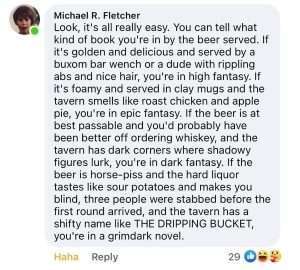
Source: Facebook
The gray morality depicted in grimdark stories, i.e., the moral ambiguity that governs characters’ motivations or actions, often implies that evil is a matter of perspective. Although grimdark stories are bleak, this does not mean they are without hope. Indeed, the best grimdark stories still provide a glimmer of that hope, something for which the protagonist would shout into the void, make their last stand, or cross moral boundaries. In our experience, people resonate with grimdark stories precisely because they provide that glimmer of hope in a brutally dark world.
Lawrence describes this well in his essay, “Groping the Elephant,” which eloquently describes the nature and importance of hope in grimdark fiction:
Grimdark is often called hopeless, but in doing so people miss that it isn’t apathetic – it is (for me) characterised by defiance in the absence of hope.
Grimdark is often called nihilistic, but this misses the idea that you can accept a nihilistic truth and still choose to die for a principle you know is an emotional construct.
A grimdark “hero” has a tendency to go all in – to burn their bridges even when they don’t need the warmth. They are, in their way, an allegory for hope, in so much as having been shown there’s no meaning in the world, they still cling to some elements of it. And in those choices they are revealed.
The way it’s painted by the disapproving you would think that grimdark fiction was the literature of surrender to the inevitable. When in truth it is the story of the battle against it – sharpened by the knowledge that there’s no ultimate victory to be had.
In addition to Lawrence’s argument that those who do not enjoy (or perhaps have not experienced) grimdark fiction see these stories as a surrender to the inevitable, Anna Smith Spark, in her 2019 article “Grimdark and Nihilism” takes this argument one step further, stating that grimdark’s version of nihilism, is in fact interpreted by fans of grimdark as hope.
Grimdark Magazine’s Definition
Understanding how brief life is, how easily all that one loves can be crushed out: with that understanding comes the desperate need to hold those things close. One fragile moment of happiness, of beauty … hold it tight to your heart and treasure it, for too soon it will be gone, all things die, all things fade, darkness comes and the light is so weak. The old lie, ‘Death or glory! Death! Death! Death!’ No: remember how fragile life is and how pointless, and cling on to life.
That thin pathetic line between rage and despair: that’s hope.
The voice screaming into the abyss: that’s hope.
Hold those you love close to you. Recognise that the world’s a cruel place.
Grimdark is that awareness. The reality of pain, the knife blade cutting in. And the determination to go on, keep on, fight on. There are no heroes, no certainty, there’s no bright shining prophecy of light. Just messed-up selfish wretched people trying to live their lives as best they can, trying to find something of love and happiness, trying to survive all the pain life brings. One single moment of beauty. One single glimpse of something good. A tiny perfect fragment in a damaged life.
Grimdark nihilism is hope, I think.
While Lawrence, Fletcher, and Smith Spark have given us clues about what constitutes grimdark, none of their approaches offers a formal definition. Here at Grimdark Magazine, we use the following definition when considering what we want to publish in our ezine, novellas, collections, and anthologies:
grimdark –
(noun) a bleak story with a glimmer of hope told in a hostile setting featuring morally gray characters;
(adjective) (of speculative fiction) characterized by a bleak story with a glimmer of hope, hostile setting, and morally gray characters.
Grimdark is often considered to be a subgenre of fantasy dating back to the 1984 publication of The Black Company by Glen Cook, which predates “grimdark” as a word. Although the term “grimdark” is most often applied to fantasy literature (see our list of Grimdark Fantasy: Where to Start Reading), the term is not restricted to fantasy but rather can apply to any form of speculative fiction, including fantasy, science fiction, horror, the supernatural, magical realism, historical fiction, and dystopian fiction. Rather than being a subgenre in itself, we consider grimdark as a crosscutting label that can be applied to any of these subgenres of speculative fiction. That is why Grimdark Magazine covers all forms of grimdark across genres and media.
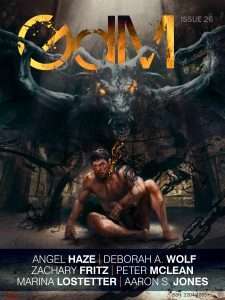 However, some people use the term “grimdark” as a pejorative for works that include gratuitous violence or promote nihilistic worldviews. This view of grimdark is unfortunate and, in our view, inaccurate. Grimdark does not imply a certain level of violence, and it most certainly does not imply gratuitous or sexual violence. Nor does grimdark imply the promotion of nihilism. In his essay, “The Future is Grimdark” author and Grimdark Magazine contributor Aaron S. Jones writes, “The darker the darkness is, the more powerful even the smallest ray of light becomes as it penetrates that darkness. And that’s what grimdark is. These stories are filled with a darkness that is soul-crushing and tormenting but then it offers a glimmer of light that keeps us going.”
However, some people use the term “grimdark” as a pejorative for works that include gratuitous violence or promote nihilistic worldviews. This view of grimdark is unfortunate and, in our view, inaccurate. Grimdark does not imply a certain level of violence, and it most certainly does not imply gratuitous or sexual violence. Nor does grimdark imply the promotion of nihilism. In his essay, “The Future is Grimdark” author and Grimdark Magazine contributor Aaron S. Jones writes, “The darker the darkness is, the more powerful even the smallest ray of light becomes as it penetrates that darkness. And that’s what grimdark is. These stories are filled with a darkness that is soul-crushing and tormenting but then it offers a glimmer of light that keeps us going.”
Jones notes that grimdark stories can resonate especially well with audiences when we are dealing with our own challenging times in history: “It brings people together and in the darkest of times, isn’t that what we need more than anything else? Grimdark stories can distract us from life, teach us about life, or just keep us alive at times. In dark times, grimdark can be the light that shines through.” Beyond books, Jones also notes the recent rise of grimdark in films and television during the contemporary landscape of war, famine, global warming, mental health, addiction, and a range of other factors impacting the globe’s first, second, and third world societies.
Once again referring to “Grimdark and Nihilism” by Anna Smith Spark, in this essay, the author also expands on this distinction between grimdark and nihilism, noting the inherent political dimension within much of grimdark fiction: “To me ‘grimdark’ is distinct from dark fantasy in that it has a very clear political dimension, a narrative cynicism that unpacks ideas like ‘leadership’, ‘power’, ‘good and evil’ and raises some uncomfortable questions about how we think about them. Grimdark asks questions about how power operates, uses fantasy to comment on huge issues of human morality and motivation, asks us to think a bit deeper about what we might do. It’s about cynicism, self-criticism, it’s actually very much a genre that criticises and politicises ‘righteous’ violence.”
Moving to an Inclusive FutureThe cultural importance of grimdark is shown by the diversity of authors writing works of grimdark fiction around the world. Grimdark has been used as a vehicle for telling stories of racial oppression, addressing issues of sexuality or gender identity, and coping with physical trauma or mental illness. Grimdark authors—and grimdark readers—come from all backgrounds. We believe that the diversity of the grimdark community is one of its greatest strengths, and that’s why we are delighted to feature content by authors from all walks of life.
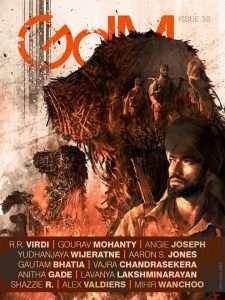 In addition to the authors who have formed the core of what grimdark fans have read over previous decades, a long list of powerfully diverse stories by authors who have helped grow grimdark beyond its generally European fantasy and American cyberpunk roots have helped grimdark reach far into fandom. Authors such as R.F. Kuang (The Poppy War) and Gourav Mohanty (Sons of Darkness) have showcased grimdark stories centred outside of western historical foundations, while authors such as C.L. Clark (The Unbroken), Lee Mandelo (The Woods All Black), and Tamsyn Muir (Gideon the Ninth) have brought LGBTQIA+ characters to the fore.
In addition to the authors who have formed the core of what grimdark fans have read over previous decades, a long list of powerfully diverse stories by authors who have helped grow grimdark beyond its generally European fantasy and American cyberpunk roots have helped grimdark reach far into fandom. Authors such as R.F. Kuang (The Poppy War) and Gourav Mohanty (Sons of Darkness) have showcased grimdark stories centred outside of western historical foundations, while authors such as C.L. Clark (The Unbroken), Lee Mandelo (The Woods All Black), and Tamsyn Muir (Gideon the Ninth) have brought LGBTQIA+ characters to the fore.
The rise of self-publishing has also been a boon for enhancing the diversity of the grimdark community. Indie books often feature some of the most creative approaches to grimdark fiction, pushing the boundaries of what has hitherto been explored through conventional publishing. Ben Galley wrote about a golem in Heart of Stone, while M.L. Spencer flipped the script on the farmboy becomes hero tale in Chains of Blood. Grimdark Magazine proudly features quality work from both indie and traditionally published authors, and we encourage readers to check out our list of ten recommended indie grimdark novels.
In our articles Grimdark Fantasy: Where to Start Reading and Cyberpunk: Where to Start Reading, we paid homage to those authors who paved the way for our kind of fantasy and science fiction over the previous decades (Martin, Cook, Scott, Abercrombie, Smith Spark, Gibson, Lawrence, Morgan, Bakker) while also revelling in the new, diverse range of stories coming from authors from a more diverse range of backgrounds, genders, sexualities, and cultures. Considering this unprecedented diversity of offerings, we’d argue that there has never been a more exciting time to be a grimdark fan.
Support Grimdark Magazine as we continue to push the boundariesOur team of authors, editors, artists, designers, reviewers, and non-fiction writers will keep pushing the boundaries of our subgenre–delivering more of what you love while finding new ways to drop your jaw to the table. If you’d like to support us, please join our Patreon for a mere US$4 a quarter by clicking on the link below.
The post Defining Grimdark Fantasy and SF: Moving to an Inclusive Future appeared first on Grimdark Magazine.
July 13, 2024
REVIEW: Arm of the Sphinx by Josiah Bancroft
Arm of the Sphinx is Josiah Bancroft’s swashbuckling sequel to Senlin Ascends and the second entry in his Books of Babel tetralogy. This second book has a very different feel compared to Bancroft’s debut, which focused almost exclusively on its lead protagonist, Thomas Senlin, a small-town schoolteacher whose honeymoon at the Tower of Babel turns into a Kafkaesque nightmare as he searches for his lost wife, Marya, across stratified layers of absurdity. In contrast, Arm of the Sphinx adopts a more conventional narrative structure, with multiple points of view from Senlin and his companions.
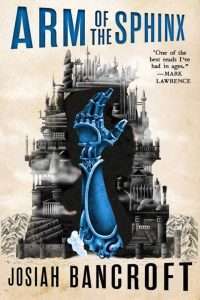 Arm of the Sphinx opens with Senlin in the guise of Captain Tom Mudd, an airship pirate causing fear and disruption outside the walls of the Tower of Babel. Senlin’s motley crew includes the scrappy fighter Iren and siblings Adam and Voleta Boreas. Adam is an engineer of questionable loyalty who committed the original sin against Senlin upon his initial entry into the Tower. His adventurous sister, Voleta, is a delight and proves to be one of the highlights of the book.
Arm of the Sphinx opens with Senlin in the guise of Captain Tom Mudd, an airship pirate causing fear and disruption outside the walls of the Tower of Babel. Senlin’s motley crew includes the scrappy fighter Iren and siblings Adam and Voleta Boreas. Adam is an engineer of questionable loyalty who committed the original sin against Senlin upon his initial entry into the Tower. His adventurous sister, Voleta, is a delight and proves to be one of the highlights of the book.
However, the real star of Arm of the Sphinx is Edith Winters, Senlin’s friend who lost an arm due to an infection in the first book. Edith is a beacon of feminism, refusing to be put down in this male-dominated world. She turns her disability into a strength with a steampunk prosthetic arm. However, a question arises about whether Edith controls her arm or the arm controls her.
Senlin himself has grown significantly since the first book, where he was a mostly passive character falling victim to the schemes of the Tower. Senlin’s new take-control attitude in Arm of the Sphinx is welcome character development, although his assertiveness diminishes some of the Kafkaesque aspects of the story that I thoroughly enjoyed in the first book. It’s also frustrating that he makes at least as many bad decisions as good ones.
Plotwise, there is plenty of adventure but less vertical ascent in Arm of the Sphinx. Much of the book is spent trying to regain access to the Tower so that Senlin can resume the search for his missing wife, Marya. The focus on piracy in this second volume recalls a similar approach taken by Scott Lynch in Red Seas Under Red Skies, the follow-up to The Lies of Locke Lamora in his Gentleman Bastard series. While I’m personally not a fan of the pirate trope, I found the pirate adventure more convincing in Arm of the Sphinx compared to Red Seas Under Red Skies. Also, as a longtime Final Fantasy fan, I must say that airships are objectively cooler than the normal seafaring variety.
While I personally preferred the Kafka-inspired absurdities of the first book, I believe fantasy fans will find Arm of the Sphinx more immediately accessible than the labyrinthine Senlin Ascends. Arm of the Sphinx offers more straightforward adventure thrills while also providing new perspectives on this dark world. The Books of Babel tetralogy continues with The Hod King and finally The Fall of Babel.
Read Arm of the Sphinx by Josiah BancroftThe post REVIEW: Arm of the Sphinx by Josiah Bancroft appeared first on Grimdark Magazine.
July 12, 2024
REVIEW: Lost Souls by Ryan Skeffington
Lost Souls, the debut novel from indie author Ryan Skeffington, is a dark science fiction thrill ride that leaves plenty of emotional devastation in its wake. The novel opens in the year 2070 with passengers on a spaceship awakening from a three-year cryogenic freeze after fleeing global destruction on Earth. But the cryogenic freezing process takes its toll: many passengers wake up to find themselves missing limbs, and some never wake up at all.
 The spaceship’s destination is an asteroid composed entirely of xantium, a “bio-metallic rare-non-earth metal” that can absorb incredible amounts of energy to be released at a later point in time. Xantium is reminiscent of another fictional extraterrestrial metal, viz., the coveted vibranium which pervades the Marvel Universe. Like vibranium, xantium has seemingly miraculous properties when interacting with organic matter such as biological tissue. Hence, xantium is considered an essential building block for humanity’s long-term survival in space and may provide a pathway toward the so-called Infinite Existence.
The spaceship’s destination is an asteroid composed entirely of xantium, a “bio-metallic rare-non-earth metal” that can absorb incredible amounts of energy to be released at a later point in time. Xantium is reminiscent of another fictional extraterrestrial metal, viz., the coveted vibranium which pervades the Marvel Universe. Like vibranium, xantium has seemingly miraculous properties when interacting with organic matter such as biological tissue. Hence, xantium is considered an essential building block for humanity’s long-term survival in space and may provide a pathway toward the so-called Infinite Existence.
The first few chapters in Lost Souls jump quickly through time, advancing from year 2070 to 2123 and then 2133. Interestingly, the thirteen chapters in Lost Souls are named sequentially after the songs from the critically acclaimed “Deep Blue” album by Australian metalcore band Parkway Drive. Each chapter starts with a quote from the corresponding Parkway Drive song, echoing the main themes from that song throughout the chapter. I really enjoyed deciphering the multiple layers of meaning that Ryan Skeffington incorporated in this work. As an added bonus, “Deep Blue” provides the perfect soundtrack for reading the book.
Although Lost Souls bounces among various perspectives, the main point-of-view character is Maximus, a brilliant xantium engineer who is trying to meet (or exceed) the impossibly high expectations set by the work of his father and grandfather while also determining his own unique path. His personal struggles are set against the backdrop of an epic battle between freedom and tyranny. With the fate of humanity in his hands, the stakes could not be any higher.
It’s hard to believe that Lost Souls is a debut novel. Ryan Skeffington writes with a strong command of both the hard science and emotional aspects of the novel, balancing the large-scale conflict with heart-wrenching personal struggles from Maximus and several side characters. Although the writing feels a bit dense at times, the author propels the story forward at a steady pace, building up to an astonishing climax that left my mouth agape in disbelief. Skeffington also makes effective use of gray morality throughout the novel.
Altogether, Lost Souls is a stellar debut by an electrifying new voice in dark science fiction and a must-read for grimdark fans looking for their next sci-fi fix. The story will continue with the next installment in the Infinite Existence series.
This review was first published in Grimdark Magazine #39.
Read Lost Souls by Ryan SkeffingtonThe post REVIEW: Lost Souls by Ryan Skeffington appeared first on Grimdark Magazine.
July 11, 2024
REVIEW: Conan the Barbarian #12 by Jim Zub (W) and Roberto De La Torre (A)
At the climax of Conan the Barbarian issue #11, the nefarious skull-headed sorcerer Thulsa Doom burst from his crypt, dealing King Kull a devastating sword blow. Master of the alien Black Stone that has been the catalyst for the deathly magic hounding Conan’s steps through the entire first year of the Titan Comics series, Thulsa Doom stands poised to not only topple Kull’s kingdom of Valusia, but also to establish “a new age of Doom”: an immortal empire of evil capable of subjugating humanity well into the distant future of Conan’s own Hyborian Age. Cosmic power floods into Doom as Kull lies writhing in a pool of his own blood. The only obstacle to the would-be tyrant is Conan, a barbarian of humble origin, lacking any noble lineage and displaced in time. Wielding his Pictish blade, Conan leaps into the fray.
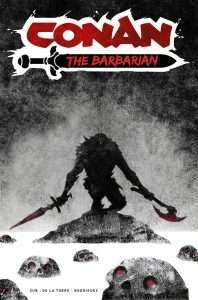 Entitled “Terror Undreamed Of!”, this issue marks both the conclusion of the current “The Age Unconquered” storyline and the culmination of the first year of the Titan Comics incarnation of Conan the Barbarian. While the narrative itself is straightforward—consisting of the duel between Conan and Thulsa Doom, with a brief flashback to the sorcerer’s mortal life and rise to power—it feels like the creative team have pulled out all the stops for this issue.
Entitled “Terror Undreamed Of!”, this issue marks both the conclusion of the current “The Age Unconquered” storyline and the culmination of the first year of the Titan Comics incarnation of Conan the Barbarian. While the narrative itself is straightforward—consisting of the duel between Conan and Thulsa Doom, with a brief flashback to the sorcerer’s mortal life and rise to power—it feels like the creative team have pulled out all the stops for this issue.
Roberto De La Torre’s artwork has been a highlight of the eight issues he handled, but in addition to the dynamic battle sequences readers have come to expect De La Torre is also given license to let loose with his depiction of Doom’s sorcerous might. The issue is packed with impressive full-page spreads showing Doom reveling in his magical powers, monologuing maniacally on backgrounds crackling with mystical lightning. While invariably exciting and action-packed, De La Torre’s artwork hewed towards gritty realism in previous issues, giving the over-the-top cosmic, sorcerous scenes of this issue even more visual impact.
Jim Zub likewise seems to have had a great deal of fun scripting this issue. Thulsa Doom’s dialogue is both arrogant and unhinged in classic pulp villain tradition. It’s also possibly a bit on the verbose side for someone engaged in a desperate sword battle with an opponent like Conan, but not having to breathe presumably allows Doom to expound at length about his superiority and wicked plans while trading blows with the barbarian. Zub’s narration matches Doom in its gleeful breathlessness, occasionally unleashing bursts of alliteration (e.g., “…the necromancer’s scornful soul merges with the star-splashed sorcery of the stone and its source.”). Lettering in comics tends to be unobtrusive, but Richard Starkings and Comicraft’s Tyler Smith take the opportunity to punch up Thulsa Doom’s grave threats and dire pronouncements with eye-catching typefaces and splashes of bold color.
With issue #12, Titan Comics’ Conan the Barbarian ends its first year on a high note. Personally, I would have preferred the series spend less time on long-form storytelling and the Black Stone plot device; Conan isn’t a character that demands a great deal of established continuity. In this initial year I also wish the series had focused more on delivering solid solo Conan adventures rather than using time-traveling crossovers to soft-launch a Robert E. Howard comic universe on behalf of rightsholders Heroic Signatures. While Jim Zub has taken Conan the Barbarian in a different direction than I predicted, the artwork remains fantastic and the stories engaging. The “Battle of the Black Stone” event miniseries teased with this year’s Free Comic Book Day issue makes it clear that Zub isn’t yet done with the Black Stone and character crossovers, but issue #12 leaves Conan in an exciting situation ripe with possibility. Conan the Barbarian Year Two is full of potential.
Read Conan the Barbarian #12The post REVIEW: Conan the Barbarian #12 by Jim Zub (W) and Roberto De La Torre (A) appeared first on Grimdark Magazine.
July 10, 2024
REVIEW: Freakslaw by Jane Flett
Jane Flett’s debut, Freakslaw, is an odd duck. Revelling itself in the weird (and sometimes non-sensical), this circus-set novel is more Stephen King than wholesome family entertainment. It’s not quite a horror novel or a straight-forward fantasy novel. Just like its characters, Freakslaw refuses to be neatly categorised. While very different in details, it reminds me of Heather Parry’s Orpheus Builds a Girl, genre-wise – literary, experimental and creepy with a strong narrative voice. There are supernatural elements to the story, though they are incidental. At its heart, Freakslaw is a glimpse into its inhabitants, into how the circus interacts with the people on its periphery.
 Freakslaw is set in the Scotland of the 1990s. A strange circus – the Freakslaw – lands in Pitlaw, a small town, confronting it with the queer and unusual. There is Gloria, teller of fortunes and story, her daughter Nancy, a contortionist, both witches. Gretchen, drag performer and self-proclaimed “gender pest” and a young woman only known as Pin Gal, a literal human pincushion among many more. They are unpredictable, and break the collective mind of Pitlaw’s inhabitants. Still, they fascinate the town’s younger generation, especially Ruth, a good and studious girl and Derek, a boy on the cusp of adulthood and discovering his sexuality. All characters are darker (and more broken) than they seem at first glance, working as both overarching archetypes and personal examples of how small, conservative towns handle difference.
Freakslaw is set in the Scotland of the 1990s. A strange circus – the Freakslaw – lands in Pitlaw, a small town, confronting it with the queer and unusual. There is Gloria, teller of fortunes and story, her daughter Nancy, a contortionist, both witches. Gretchen, drag performer and self-proclaimed “gender pest” and a young woman only known as Pin Gal, a literal human pincushion among many more. They are unpredictable, and break the collective mind of Pitlaw’s inhabitants. Still, they fascinate the town’s younger generation, especially Ruth, a good and studious girl and Derek, a boy on the cusp of adulthood and discovering his sexuality. All characters are darker (and more broken) than they seem at first glance, working as both overarching archetypes and personal examples of how small, conservative towns handle difference.
The novel chafes up against society. It is at times uncomfortable, certainly not an easy read. Freakslaw has a strong narrative voice, an all-knowing narrator telling the story in fragments, jumping perspectives and playing with how much to tell the reader. In that, it fits in nicely with the trend for experimental, quiet and creepy horror-adjacent novels. While there are supernatural elements to this, it is more concerned with the human. Its 1990s setting combined with the strange brought by the Freakslaw works well to highlight how many of the social issues faced haven’t progressed in almost thirty years. It allows Flett to hold a mirror to the reader, using its setting as an unfamiliar world, a reverie of sorts.
Did I enjoy Freakslaw? The honest answer is “I’m not sure”. To me, it’s a novel more interesting than enjoyable, one that demands attention and reflection of the reader. It is one that I am forcing my friends to read just so we can discuss it. And that’s a great place to be as a debut author.
Read Freakslaw by Jane FlettThe post REVIEW: Freakslaw by Jane Flett appeared first on Grimdark Magazine.
July 9, 2024
REVIEW: Master Assassins by Robert V.S. Redick
Master Assassins by Robert V.S. Redick is desert fantasy par excellence, a grimdark tale of two half-brothers, Kandri and Mektu Hinjuman, on the run after they are implicated in an accidental death. Kandri and Mektu love each other as brothers but are often bitter rivals consumed by jealousy.
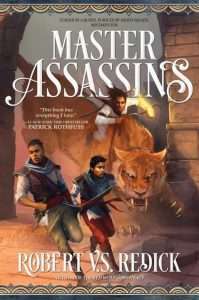 Although the novel focuses closely on Kandri and Mektu, the worldbuilding in Master Assassins steals the show. Master Assassins takes place in the vast desert world of Urrath, which is battling against a horrifying pandemic. Kandri and Mektu are soldiers in service of the Prophet, a madwoman who incites religious zealotry and warmongering among her quarantined people. However, Kandri and Mektu have doubts about the Prophet’s divinity, and an unintentional killing sends them fleeing into the vast desert known as The Land That Eats Men, pursued by a band of elite hunters (and worse).
Although the novel focuses closely on Kandri and Mektu, the worldbuilding in Master Assassins steals the show. Master Assassins takes place in the vast desert world of Urrath, which is battling against a horrifying pandemic. Kandri and Mektu are soldiers in service of the Prophet, a madwoman who incites religious zealotry and warmongering among her quarantined people. However, Kandri and Mektu have doubts about the Prophet’s divinity, and an unintentional killing sends them fleeing into the vast desert known as The Land That Eats Men, pursued by a band of elite hunters (and worse).
Kandri and Mektu have polar opposite personalities. Kandri is rational in thought and intentional in action. But with his paranoia and possible insanity, Mektu could have easily sprung out of a Fyodor Dostoevsky novel. The interplay between the two brothers is another highlight of the novel, always keeping the reader guessing about what will happen next.
The title and cover art of the book are a bit misleading, in my view. The casual book shopper could easily mistake this as a young adult novel. However, Master Assassins is grimdark to the core, featuring a very dark world riddled with violence, disease, drugs, and prostitution. But what makes Master Assassins most appealing for grimdark fans is Redick’s masterful characterization, featuring plenty of complex gray morality.
Robert V.S. Redick’s prose is literary without losing its accessibility. With its grimdark desert setting, nuanced characterization, and literary style, Master Assassins recalls Anna Smith Spark’s The Court of Broken Knives. The plague aspect of the book and the Middle Eastern-inspired worldbuilding also remind me of the Tower and Knife trilogy by Mazarkis Williams, although Master Assassins is decidedly darker in tone.
Master Assassins is grimdark fantasy of the highest caliber. Readers of Anna Smith Spark and Mazarkis Williams will find much to love in this novel, as will the growing legion of Dune fans. Robert V.S. Redick’s Fire Sacraments trilogy continues with Sidewinders, the second book of the series.
Read Master Assassins by Robert V.S. RedickThe post REVIEW: Master Assassins by Robert V.S. Redick appeared first on Grimdark Magazine.
Gladiator 2 is coming! Here’s the best dark fantasy to read between now and November 14
Last Updated on July 10, 2024
Gladiator starring prime Russel Crowe is one of the best pieces of cinema ever created. I’ve watched that movie–or had it running in the background while working on this very website–so many times I’ve lost count. To actually see the trailer for Gladiator 2 release almost twenty-five years later is both wildly exciting and absolutely terrifying to a super fan, like me. The cinematics, battles, closeness of the one-on-one combat, and Denzel Washington’s character (despite whatever that American slash something accent attempt is) have me pumped for this. The one violently intrusive thought I have is that, other than 2022’s Top Gun: Maverick, I can’t really recall the last time trying to recreate that amazing feeling of the original or taking a new spin on an old movie went well.
Whatever may come, there is the better part of half a year between now and when Gladiator 2 hits the screens, and if you’re anything like me, you’ve got an itch to read about some dark fantasy gladiators getting their feet onto the red sand. The team and I are here to help with that, starting with a book from one of the best series I’ve ever read, The Midnight Falcon by David Gemmell (Rigante quadrilogy) where gladiators Rage and Bane took to the sands for bloody adventure and vengeance.
The Midnight Falcon by David Gemmell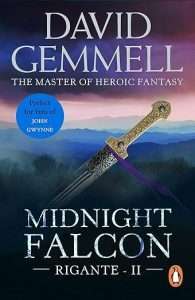 If you’re in the mood for more gladiator combat, you need to drop everything and read Midnight Falcon ASAP. When Bane the Bastard is exiled from his homeland of the Rigante highlands, he sets his sights on Stone—Gemmell’s fantasy version of the Roman Empire. All his plans turn to dust at the tip of Voltan’s blade, Bane sets off on a desperate quest for revenge.
If you’re in the mood for more gladiator combat, you need to drop everything and read Midnight Falcon ASAP. When Bane the Bastard is exiled from his homeland of the Rigante highlands, he sets his sights on Stone—Gemmell’s fantasy version of the Roman Empire. All his plans turn to dust at the tip of Voltan’s blade, Bane sets off on a desperate quest for revenge.
His training to become the best Gladiator in Stone brings him under the tutelage of Rage and Telors, famous gladiators past their prime who are training for one last desperate bout. But his quest to face Voltan in the colluseum leads to more than just one on one combat. Bane finds himself caught incredible ocean of blood as the machinations of the Emperor Jasaray and his enemies as they grapple for power and topple the great army of Stone into war with the Rigante. Incredibly sharp combat scenes, whip-smart political manoeuvring, a desperate war of people defending their home land, and some of the most brilliant character work in the genre will keep you busy while you wait for Gladiator II’s release!
About The bookBane the Bastard is the illegitimate son of the Rigante king who men called Demonblade. Born of treachery, Bane grew up an outcast in his own land, feared by his fellow highlanders, and denied by the father whose unmistakable mark he bore–the eyes of Connavar, one tawny brown, the other emerald green.
Hounded from the country of his birth, Bane found acceptance across the seas–only to have it stripped away in an instant by a cruel and deadly swordsman. Now fighting as a gladiator in the blood-soaked arenas of the Empire, Bane lives for one thing: revenge. And he pursues his goal with the same single-minded determination that won his father a crown.
But more is at stake than a young warrior’s quest for vengeance. The armies of the Stone are preparing to march on the lands of the Rigante. The fate of human and Seidh alike will be decided by the clash of swords–and by the bonds of twisted love and bitterness between a father and a son . . .
Read The Midnight FalconGodsgrave by Jay Kristoff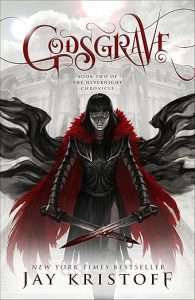 Godsgrave is the second book in Jay Kristoff’s Nevernight trilogy and a must for Gladiator fans. Set in the Republic of Itreya, there are many similarities between Kristoff’s world and ancient Rome – including the gladiator arena and the citizens’ love for blood sports. Assasin Mia Corvere sells herself into slavery for the chance to exact revenge on two of the most powerful men in the land on a rare occasion when they will both appear in public at a gladiator tournament. The only hitch? Mia has to become the champion of the battle royale to get herself close enough to assassinate them.
Godsgrave is the second book in Jay Kristoff’s Nevernight trilogy and a must for Gladiator fans. Set in the Republic of Itreya, there are many similarities between Kristoff’s world and ancient Rome – including the gladiator arena and the citizens’ love for blood sports. Assasin Mia Corvere sells herself into slavery for the chance to exact revenge on two of the most powerful men in the land on a rare occasion when they will both appear in public at a gladiator tournament. The only hitch? Mia has to become the champion of the battle royale to get herself close enough to assassinate them.
The reader gets to witness Mia’s time training rigorously in the gladiator collegium, form relationships with her fellow gladiators (some friendly, some not), and perform in the arena. There are numerous fast paced gladiator battles described by Kristoff in all the bloody gory detail imaginable. The gladiators are mostly new characters to the series and Kristoff spends time to build them up, giving back stories and tales of their lives before slavery giving the reader greater insight in to this world. As the second book in the trilogy it isn’t the best starting point, but gladiator Mia is just as entertaining as assasin Mia and is must read for those who want more blood stained sands in their reading material.
Read our review here.
About the bookThe second thrilling installment of the award-winning Nevernight Chronicle, from New York Times bestselling author Jay Kristoff.
In a land where three suns almost never set, a ruthless assassin continues her quest for vengeance against the powers who destroyed her family.
Mia Corvere has found her place among the Blades of Our Lady of Blessed Murder, but many in the Red Church hierarchy think she’s far from earned it. Plying her bloody trade in a backwater of the Republic, she’s no closer to ending the men who destroyed her familia; in fact, she’s told directly that Consul Scaeva is off limits. But after a deadly confrontation with an old enemy, Mia’s suspicions about the Red Church’s true motives begin to grow.
When it’s announced that Scaeva will be making a rare public appearance at the conclusion of the grand games in Godsgrave, Mia defies the Church and sells herself to a gladiatorial collegium for a chance to finally end him. Upon the sands of the arena, Mia finds new allies, bitter rivals, and more questions about her strange affinity for the shadows. But as conspiracies unfold within the collegium walls, and the body count rises, Mia will be forced to choose between love and revenge, and uncover a secret that could change the very face of her world.
Read Godsgrave by Jay KristoffBuzzard’s Bowl by John Palladino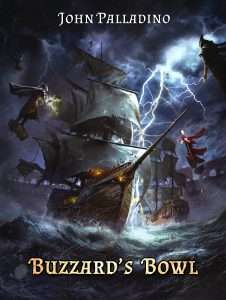 Buzzard’s Bowl, the second volume of John Palladino’s grimdark fantasy series, The Tragedy of Cedain, features plenty of gladiator action. Edelbrock Brendis is a former minor nobleman who, through his own strategic missteps, becomes an enslaved gladiator fighting in the Buzzard’s Bowl arena. Edelbrock is a deeply pathetic and tragic figure, drawing equal parts sympathy and repugnance, but he grows significantly throughout Buzzard’s Bowl while oscillating between depth and shallowness of character.
Buzzard’s Bowl, the second volume of John Palladino’s grimdark fantasy series, The Tragedy of Cedain, features plenty of gladiator action. Edelbrock Brendis is a former minor nobleman who, through his own strategic missteps, becomes an enslaved gladiator fighting in the Buzzard’s Bowl arena. Edelbrock is a deeply pathetic and tragic figure, drawing equal parts sympathy and repugnance, but he grows significantly throughout Buzzard’s Bowl while oscillating between depth and shallowness of character.
Buzzard’s Bowl is full of fast-paced action with plenty of surprises for each of the main characters, especially when their storylines converge. Palladino shines in writing pulse-pounding action sequences. My favorite is the scene captured on the outstanding cover designed by Dusan Markovic, which depicts a flooded Buzzard’s Bowl arena with battling gladiator ships electrified by levitating Magicai wizards. This is one of several epic action sequences in the book that grimdark fans will adore.
Read our review here.
About the bookCedain continues to collapse.
Ashmount’s destruction shatters the Magicai while the culprits responsible continue sabotaging the world. All the while, the next season of Buzzard’s Bowl begins and Edelbrock, in his constant fight for survival, desires a vengeance he can only find in the arena.
Seradal and Villic find themselves in the middle of a war between Remeria and the Camel Clans, and may end up on opposing sides, while the threat of Calrym looms over all of them.
At the behest of the woman he loves, Demri finds himself thrown into the Elkavich, a not-so-secret order of Magicai who are intent upon fixing the world.
Ashen, a former urchin rescued by a noble with selfish aspirations, works to dismantle the nobility of Calrym.
Death is assured to all who walk the world, the only unknown is when they will perish.
Read Buzzard’s Bowl by John PalladinoThe post Gladiator 2 is coming! Here’s the best dark fantasy to read between now and November 14 appeared first on Grimdark Magazine.
July 8, 2024
REVIEW: Unexploded Remnants by Elaine Gallagher
Unexploded Remnants is the debut novella by Scottish author Elaine Gallagher and tells the story of Alice, who is the last surviving human and spends her time seeking out unusual artefacts for preservation and/or safety. One such rummage throws up an artefact that looks like a lava lamp—the book is full of 20/21st century references—but is in fact an AI soldier from a long-ago war. This of course leads to a breathless chase across the galaxy to find the entity (taking the name of “Gunn”) a safe and ethical outcome while dubious forces seek to obtain it and dispose of Alice as collateral.
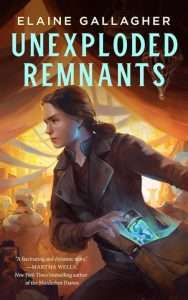 Imagine a queer Indiana Jones/Tomb Raider story that sprawls through a diverse universe reminiscent of both Star Wars and the Culture, with added Stargate and Doctor Who elements. Unexploded Remnants is a wild ride that starts off a top speed and rarely lets up.
Imagine a queer Indiana Jones/Tomb Raider story that sprawls through a diverse universe reminiscent of both Star Wars and the Culture, with added Stargate and Doctor Who elements. Unexploded Remnants is a wild ride that starts off a top speed and rarely lets up.
That worldbuilding is a key part of Unexploded Remnants as Gallagher offers a glimpse into a galaxy where anything seems possible and proceeds at a brisk pace from the kind of market you’d expect on Tatooine through salvage yards, overwhelming cyberpunk vistas and a more sedate city just in the opening sequence. There are hints of a vibrant, exciting universe begging to be explored in more detail and I really want to see it.
Alice’s backstory is similarly fascinating, but not overly dwelt upon. She’s a trans woman who fell upon the portal network one day and ended up as a freelancer for ‘the Archive’ and was thus saved from Earth’s resulting climate collapse, becoming the last human. Those themes of queer representation, being the last of your kind and trying to make your way when out of time and place are integral to the story, especially those points of empathy between Alice and Gunn.
One line that stuck out to me was during Alice and Gunn’s initial conversation where Gunn replies “You count me as ‘people,’ then?” That’s the key element of the story and couldn’t be a more apt theme for these times.
While somewhat outside the usual grimdark vein, I feel that Unexploded Remnants will be a good book for fans of the gritty and morally grey to pick up. Alice’s job as a freelancer picking up antiquities is inherently grey and this universe is far from noblebright or possessing a black and white morality between factions. Furthermore, the key plot points of who counts as people, free will and making hard decisions are at the heart of the grimdark, even if the story isn’t rubbing our nose in mud, blood and swearing.
All in all, this novella is great fun, both thought provoking, action packed and rattles along at a brisk pace with evocative writing that offers plenty of description but doesn’t linger overly on exposition. If I had a criticism it’s that Unexploded Remnants left me wanting more. Like so much in recent years from Murderbot to This is How You Lose the Time War, the novella format is great at giving a digestible amount of science fiction for busy modern lives, but so often leave you wishing for more and Unexploded Remnants is no different. More please.
Read Unexploded Remnants by Elaine GallagherThe post REVIEW: Unexploded Remnants by Elaine Gallagher appeared first on Grimdark Magazine.

 Read on Amazon
Read on Amazon

